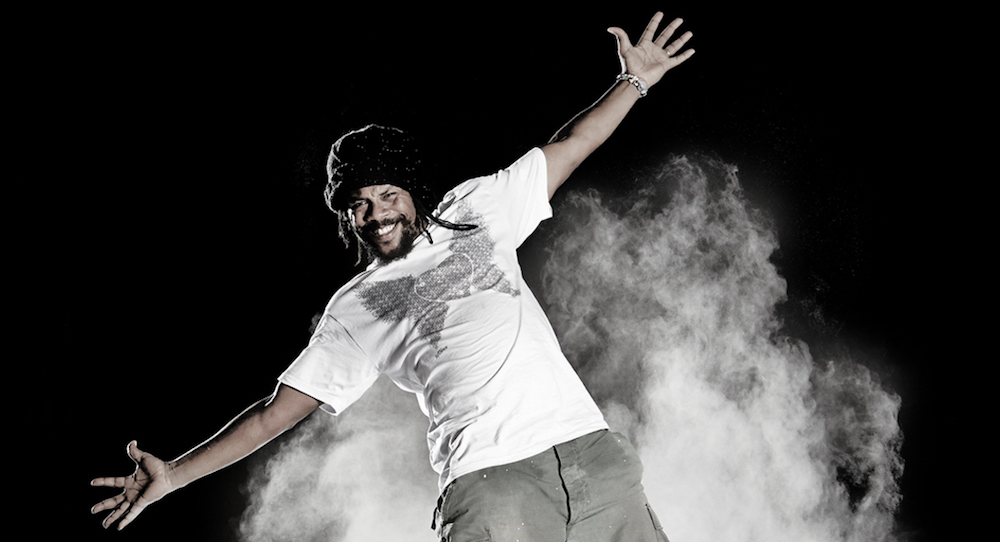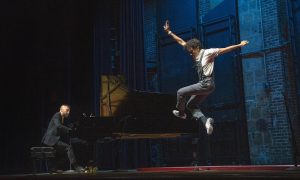There’s a celebration in New York City this May, and Dormeshia Sumbry-Edwards, Derick K. Grant and Jason Samuels Smith are inviting all tap dancers and enthusiasts to join them for the first annual Tap Family Reunion to celebrate National Tap Dance Day. This collaboration between three award-winning and influential world-class tap dancers willcelebrate the art of tap dance and will encourage tap dancers to gain an even deeper appreciation of the culture and history of this artform.
This dynamic trio, who individually have achieved successful tap dance careers, have decided to work together to develop the Tap Family Reunion to impart their love and knowledge of tap dance to the next generation.
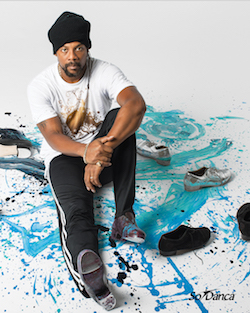
Derick K. Grant. Photo courtesy of Só Dança.
“Part of the challenge in the tap community is that your stiffest competition tends to be your best friends,” Grant tells Dance Informa. “You know there aren’t a lot of tap jobs, so whenever there’s a job, everybody is kind of bumping heads to get it. I think the Tap Family Reunion is an example of three professionals working together to create. So rather than trying to outdo each other for the little bit that exists, we try to come together and make magic happen, and hopefully that will create a trend where dancers are inspired to work with each other to create.”
The Tap Family Reunionisn’t looking to replicate a typical tap dance festival format but rather create something unique that connects tap dance to the city of New York. “We’ve all been a part of the tap festival community, and we felt like it started to get away from celebrating the form and its relationship with the city,” Grant says. “I feel like New York City is the mecca of tap dance. When you look at all the amazing music that’s going through here and all the different people who come from all over the world to New York, it’s just a hub. It’s also recognized as one of the birth places, if not the birth place, of tap dance, and we don’t celebrate it enough.”
What makes the Tap Family Reunion unique is that it offers one day of tap classes within its three-day schedule, so the schedule is not dominated by classes but instead aims to build knowledge and provide education in tap history. Some of the more distinctive activities that students can expect to participate in include the Tap Family Feud, a twist on one of America’s most popular gameshows where contestants’ knowledge of tap dance is put to the test, and Footsteps of Giants, a guided interactive tour racing against time to seek out monuments throughout New York City that are significant to tap dance history and culture. With a passion for educating tap dancers on the artform, Grant feels that the best approach is to make it interesting, challenging and fun for the students.
“People tend to feel that learning history is a chore, and if you can make it fun then you’ll have people who are eager to learn more, and that’s when we’re headed in the right direction as a community,” says Grant, who also believes that appreciating the traditions of tap dance and acknowledging the teachers and tap elders who have contributed to the artform is also of utmost importance. “Tap dance has always been about celebrating our teachers and all the dancers who came before us. When I grew up as a young person, fortunately I had a woman by the name of Dianne Walker, who is an amazing tap master. She would bring me on gigs, and I got to watch the older cats, and I dreamed of a day when I could carry on that tradition, and so I take it extremely seriously. Any students of mine understand the gravity of being connected because anything I teach, I tell them that this comes from this person and this comes from this person. It’s just tradition. Can somebody dance without being connected? Certainly you can learn the steps, and of course you could learn the mechanics of tap dance without learning the history, but when you express yourself, there will be something missing, I promise.”
Other features of the event are the Cutting Contest, which is a tap dance improvisation battle, and a show titled Raising the Bar, celebrating the timeless relationship between tap dance and jazz music.
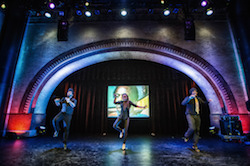
Tap Family Reunion. Photo by Marc Millman, courtesy Divine Rhythm Productions.
“Jason is known for reintroducing the tap community to the Cutting Contest,” Grant explains. “It’s something he’s extremely passionate about, so we’re going to show people how it’s done. Instead of just having a faculty show, we decided to use this opportunity to produce a real show, mainly to create a platform to give some of these special dancers who are surrounding us an opportunity to shine but also to remind our community that this is a performance-based artform as well and that they should be used to being on stage. I think a lot of people are comfortable and like the feeling of community in class, but I just feel like we’ve been stuck for awhile, and people need to go beyond class and get back on stage. So the Tap Family Reunion is just a nod to all of that and leading by example.”
Another aspect of the event that students are sure to enjoy is Tap Con, an interactive marketplace where they’ll find all things tap dance from tap shoes to footage, cultural relics and more. As an ambassador for Só Dança, Grant is enthusiastic about designing tap shoes that meet the needs of the tap community. When looking for the perfect tap shoe, he explains there are three important factors to consider.
“It’s about fit, sound and style,” he says. “You want it to feel good on your foot, and since it’s an instrument, you want it to sound good, and then of course you want it to look as good as possible, but that’s kind of last. I love shoes in general, so being affiliated with a shoe company has been a blessing. I’m also a huge sports guy, and I’ve always dreamed of the day that like athletes, dancers could be sponsored by major companies and supported in that way, so when it came into fruition, I thought that was magical.”
What Grant loves about the Só Dança tap shoe is that it’s a versatile instrument, especially when he needs to quickly switch from producing heavy sounds to lighter sounds in his performance. “As dancers, we try and develop our sound, and part of that equation is your shoe and the surface that you dance on,” he explains. “For me, Só Dança has a lighter sound, and so I can be light when needed, and when I want it to be stronger, I just put my energy behind the notes, and I can be as strong and powerful as I need to be as well. There are quite a few shoes on the market that are heavy by nature, so it’s virtually impossible to lighten up and get those subtle light crispy notes, so I’m really proud of that and its ability to produce a consistent sound.”
Grant and Só Dança have a two-way partnership, which means they are continually working together, addressing feedback to constantly improve their shoes. “If there’s something particular about the shoe or things that I’m hearing in the world of dance about tap shoes in general, then we can address it directly, and that’s been amazing,” Grant says. “They hang on every word and really work hard to meet anything that I can imagine. I come up with some crazy designs, and they’re on board all the time. As a result, we’ve made some special shoes, and we continue to keep pushing the envelope. And there have been quirky things. I’ve learned way more about feet than I’ve wanted to know in terms of people’s wide heels and thin heels, the bridge of people’s feet and all kinds of crazy things.”
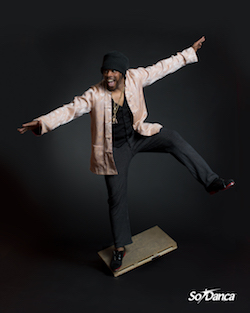
Derick K. Grant. Photo courtesy of Só Dança.
Having great shoes is a starting point; however, Grant also stresses to his students in New York to get to know, master and fall in love with their own distinctive sound. “Certainly, it’s important to learn steps and to learn people’s philosophies and approaches, but I feel like tap dance is a language, and I’m trying to teach you how to speak for yourself,” he shares. “I’m not just trying to teach you how to recite my poetry. I don’t want you to just learn how to do my dances, I want you to be able to speak for yourself in this new language, so that’s what we work on – our sound, being able to identify it, control and manipulate it, master it and express ourselves.”
Beyond the technical aspects of tap dance, Grant places importance on the need to foster a supportive culture within tap dance, which is what family is all about. The Tap Family Reunion is an environment in which students can be inspired to grow and learn and not self-hate. “I feel like it’s more natural to beat yourself up when you watch people who you consider are exceptional at something,” Grant says. “Instantly, it makes you question yourself. Like, ‘Wow, they’re really good. I wish I was that good.’ Or, ‘Why am I not that good?’ For me, when I see somebody who’s good, and even since I was a kid, I would leave every tap show dancing in the lobby, dancing in the street, dancing until I got home, dancing in my pajamas; until I got into bed, I was dancing. I was so inspired, and that’s the same now. When I see someone who’s really good at what they do, I just start dancing. It inspires me to practice, and I think that’s the point. It’s important to be honest with yourself. It’s natural to be critical but not to bully yourself. I feel a lot of people bully themselves, a lot of people make a habit of saying ‘I can’t’ before they even try. Let’s try and figure out a way to switch that and champion yourself and be your own cheerleader.”
The Tap Family Reunion is on May 24-27, 2018, in New York City. For tickets and more information, visit tap-family-reunion.ticketleap.com.
By Nicole Saleh of Dance Informa.


